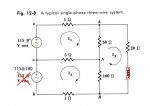With a single phase transformer, you will never get anything other than voltages at D? and D+-180? because the neutral is located on the line from D? to D+-180? (or +-D if it makes you happy). Note that this is not the case with 120/208 and that is why we call it a "network" system instead of a single-phase system.
Anyway, the purpose of the open wye configuration is to show the use of forces in the single-phase transformer windings in both directions. Normally with an open-wye, we have an open delta on the secondary that allows us to close the "V" (the leg of the "Y" is missing). Here, the three voltage points are readily available and we just have to close the "V".
With the open-wye to wye transformation, we do not close the top of the "Y", but instead use the voltages in 1/2 of the windings that are displaced by 180? from the other 1/2 to create the missing leg of the "Y". This missing leg has is a voltage point that is not readily available.
The reason I used this example is because with a single transformer, some have argued that the 180? displaced voltage is not a real voltage but just a math trick. This configuration uses two transformers and uses the 180? displaced voltages in each one to create the missing voltage in the wye.
I thought this would refute the statements that the displaced voltages were not real since these systems are actually in place and create a voltage that no one can say is not really displaced 120? from the other legs of the wye. In the open-wye to wye case, we could not create the missing leg of the "Y" if the displaced voltages were not real and really displaced.

